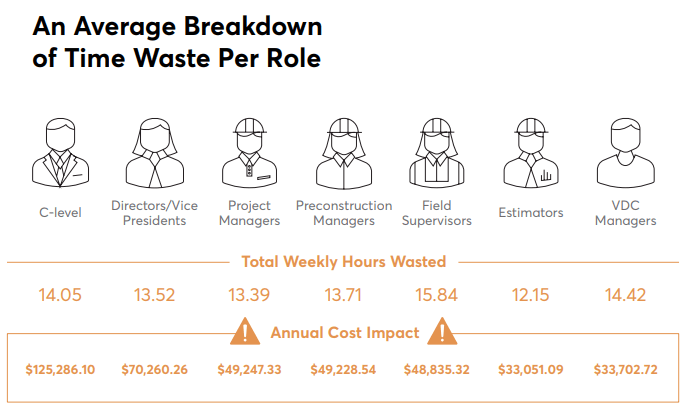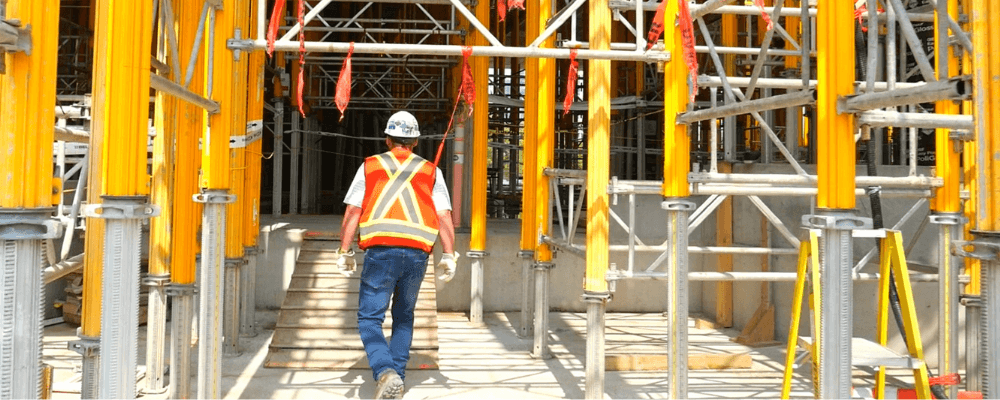If you’ve been looking at investing in construction management software, but the upfront cost is keeping you from pulling the trigger, you need to consider the significant cost of continuing to rely on manual timekeeping, paper-based forms, and inaccurate tracking.
Or maybe you’ve got a software in place, but it doesn’t cover all your jobsite needs. Using a piecemeal combination of management software, Excel spreadsheets, and a separate time tracker, for example, means you’re still losing precious time to the inefficiency of juggling multiple tools. Or, if your timekeeping app doesn’t integrate with your payroll software, you’re still subjected to tedious manual reentry, and exposed to human error.
There’s a good chance you’re losing significant amounts of money without even realizing it. And we’ve done the math to back it up.
The 3 Ways Corfix Saves You Money
Implementing Corfix as your single solution for construction management provides a swift return on investment (ROI) by streamlining processes, reducing human error, and mitigating unnecessary costs.
There are three major ways Corfix quickly pays for itself:
1. Wasted Man Hours = Lost Productivity = $1,600+ per worker (minimum)
One of the biggest and most immediate benefits of adopting Corfix is the amount of time saved. By digitizing processes, construction teams can drastically reduce the amount of time spent on manual tasks like:
- Filling out paperwork
- Searching for lost documents
- Waiting for instructions
- Correcting errors
- Rework due to lack of information or confusion
Based on a very conservative estimate, digitizing or consolidating construction processes with Corfix saves each employee at least 15 minutes per shift. Over a standard five-day workweek, that’s 15 hours of reclaimed productivity for a construction team of 35 workers.
But real studies suggest it’s more. A LOT more:
A joint study between PlanGrid and FMI in 2018 with 599 construction leaders suggests that 35% (14 hours) of time is spent on “non-optimal activities”, including 5.5 hours per week looking for project data/information.
- The 2020 National Construction Payment Report: Spring Spotlight on Jobsite Coordination showed that most construction professionals spend more than 25% of their time tracking and reporting on project progress.
- A study in the Journal of Construction Engineering and Management from 2005 found that 49.6% of construction time is devoted to wasteful activity.
- The Construction Industry Institute (CII) published a report in 2004 that stated 57% of time spent in construction is wasted time.
If you reduce the numbers in the occupation breakdown below by 70%, you get an idea of the total cost impact of the time spent “looking for project data/information”— the low end being over $10K per year, per person and the high end being $37K per year, per person.

The time saved on repetitive manual tasks such as completing forms, seeking managerial clarification, and other tasks that can easily be digitized or automated can easily be more depending on the current state of your processes.
Our own clients even suggest it’s closer to the 30-60 minute mark per worker, per day. Even for entry-level positions that equates to $270 – $540 in savings per month, per worker.
- “Our daily time cards used to take us around 30 minutes to complete, now they take about 1 minute with the help of the app.”— Dan Léger, Project Manager, Imperco
- “Having everything in digital form has saved me over an hour a day.”— Tyler, Foreman
- “Gives me hours back each week to focus on other things.” —David, President
By centralizing project information in a single digital system, Corfix eliminates much of this wasted time, allowing teams to focus on high-value tasks.
In an industry where project timelines are tight and delays are costly, every minute counts. By cutting down on these inefficiencies, construction companies can significantly improve project timelines and, ultimately, profitability.
2. Printing Paper = Hidden Cost = $1,700+ per Year
Another area where Corfix quickly proves its value is in reducing the costs associated with paper. Paperwork is an integral part of construction operations, but it’s also one of the most overlooked sources of waste and inefficiency. From printing forms and storing documents to reprinting misplaced paperwork, the costs add up quickly.
For example, a construction company with 35 employees that fills out 20 forms per week could save $32 per week just in printing costs. Over the course of a year, this adds up to nearly $1,700 saved—simply by going paperless.
This is another area where the wrong software can be just as wasteful as no software at all. If a software is not adopted by your whole team, or if it fails tests of ease-of-use and accessibility for field workers, many may still rely on paper for convenience. Or, if it doesn’t cover all your jobsite needs, some things may stay analog.
According to a report by Gartner Inc., U.S. companies spend $120 billion a year on printed forms, and a typical office worker uses an average of 10,000 sheets of paper annually. In the construction industry, this can be even higher due to the heavy reliance on forms for inspections, permits, safety documentation, and daily logs.
- “One of the advantages of Corfix is that it has completely eliminated the daily supervisor’s logbook.”— Jeff LeCourt, Site Superintendent, Claridge Homes
To put this into perspective, let’s break down the costs of paper for a typical construction team:
- The cost of printing a single sheet of paper (including paper, ink, and toner) is estimated at 40¢ per page.
- Construction teams often use carbon copy forms, which are even more expensive, averaging 73¢ per page .
- The average document is copied 9-11 times, further inflating costs.
By eliminating or drastically reducing the need for paper-based processes, Corfix can save companies hundreds, if not thousands, of dollars per year.
- “Ditching the paperwork out of my truck was huge for me. We travel all over Ontario, and my truck is my office.” —Tyler, Foreman
In addition to the direct costs of paper, there are indirect costs such as document storage and management. Physical filing cabinets take up valuable office space, and maintaining them requires labor. The Association for Information and Image Management (AIIM) estimates that every 12 filing cabinets require one full-time employee to manage . Misplaced documents are also costly—each lost document costs between $350 and $700 in employee time spent searching for or recreating it.
By digitizing documentation, construction management software eliminates these costs, allowing companies to store and retrieve documents electronically with ease. This not only saves space and labor but also improves security and ensures regulatory compliance.
3. Time Theft = Revenue Loss = $550+ per Worker
Time theft is an often overlooked but significant cost for construction companies. Whether intentional or accidental, time theft occurs when employees are paid for time they didn’t actually work. This can happen due to rounding up hours, buddy punching, or simply inaccurate time tracking.
Studies suggest that time theft is a widespread issue:
- According to QuickBooks, 49% of employees admit to time theft, and the average employee rounds up their time by 15 to 60 minutes per day.
- A Robert Half International study found that office employees steal an average of 4.5 hours per week due to inaccurate timekeeping .
For a construction company with hourly workers, even small increments of untracked time can add up to a large financial loss. For example, if an employee rounds up by just 5 minutes per shift that amounts to 21.5 hours of paid time that wasn’t worked ($550 per year for a single entry-level construction worker).
In many cases, time theft isn’t malicious but rather the result of human error. Manual timekeeping processes, such as paper timesheets, are prone to inaccuracies because they rely on employees remembering their exact clock-in and clock-out times. Delays, interruptions, and honest mistakes can lead to inflated time records.
- “From a payroll and finance administrative perspective, having quick access to employee punch in/out and location data is key to keeping our records accurate.” — Jackie, Financial Analyst
Corfix accurately logs employee hours in real-time, eliminating the potential for rounding errors, forgotten punch-outs, or buddy punching. Over time, this can save companies thousands of dollars in unnecessary labour costs.
>> Did you know? Accurate time tracking is not only important for reducing time theft but also for ensuring compliance with labour laws. In the U.S., companies are legally required to maintain payroll records for up to three years under the Fair Labor Standards Act (FLSA). Failure to do so can lead to expensive lawsuits and fines. Construction management software automates the recordkeeping process, ensuring that timesheets are stored securely and in compliance with legal requirements. <<
Ease of Use and Ease of Implementation
The second consideration, you may remember, dealt with technology easy of use and ease of implementation. Corfix is the only construction management software designed and built by former field workers, so you can be sure that it fits in seamlessly with the daily jobsite tasks and actual workflows that exist during a project.
- “The software has been built by individuals that have worked on the job site… Therefore the system was designed for efficient and simple use in the field, creating better success of implementation and buy-in.” — Jordan, Corporate Health and Safety Coordinator
It was specifically designed for ease-of-use and easy field adoption because it makes things easier instead of harder for the everyday worker. The administration side contains customizable dashboards and reports so that the information you need is always at your fingertips.
- “The program is simple to use and we had no difficulties rolling out to our staff.” — Kerri, CFO
Read more: Imperco Wins Over their Workforce with Corfix
The Bottom Line: You’re Wasting Money
Every dollar counts. By continuing to rely on outdated manual processes, you are likely inadvertently wasting valuable resources on inefficient timekeeping, paper-related expenses, and time theft. The ROI of Corfix is clear: by digitizing workflows, you can save money, improve productivity, and protect yourself from legal risks.
If you’re still tracking hours on paper and dealing with the headaches of lost documents, it’s time to rethink your approach. Corfix isn’t just an upgrade—it’s an investment that pays for itself, quickly and decisively. Looking at the calculations above, from a conservative estimate Corfix can save an average of
Don’t let inefficiencies cost you. Streamline your operations and watch your savings grow.


